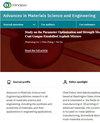基于非优势遗传算法(NSGA-II)的混合多目标优化算法,用于最小化端面铣削过程中的振动振幅
4区 材料科学
Q2 Engineering
引用次数: 0
摘要
铝是一种无腐蚀性的轻质材料,用于制造航空航天、汽车和建筑行业的零部件。由于耐低温,因此会产生更多的热量。同时,在加工过程中,为了将摩擦和颤振控制在最低限度,达到更好的质量和完美的输出,需要付出巨大的努力,同时在选择加工工艺参数时也需要更多的关注。主轴转速、进给速度、径向和轴向切削深度以及刀具的径向前角是使用高速钢刀具在数控铣床上加工铝 6063 时所使用的参数,以便使用预测模型估算主轴和工作台的振动。本研究采用响应面方法进行实验设计,利用 Design-Expert v12 软件建立二阶统计方程进行实验。采用方差分析方法对性能特征进行了分析。主轴转速在 2000 至 3000 rpm 之间的振动最小。其次,与进给速度和刀具径向前角相比,轴向和径向深度是影响振动最大的参数。为了找到最佳可行响应,使用 MATLAB 软件对非主流排序遗传算法 II (NSGA II) 方法进行了训练和测试。使用帕累托最优技术,最佳工作台振动范围为 0.00284 至 0.00165 mm/s2,而主轴振动范围为 0.02404 至 0.01336 mm/s2。在使用帕累托最优解时,发现预测值非常符合实际情况。本文章由计算机程序翻译,如有差异,请以英文原文为准。
A Hybrid Nondominant-Based Genetic Algorithm (NSGA-II) for Multiobjective Optimization to Minimize Vibration Amplitude in the End Milling Process
Aluminium is a noncorrosive, lightweight material used to fabricate parts for the aerospace, automobile, and construction industries. Due to the low-temperature resistance, more heat is generated. At the same time, in machining, tremendous efforts are taken to keep friction and chatter to a minimum and to attain better quality and perfect output, and also more attention is required while selecting the machining process parameters. Spindle speed, rate of feed, radial and axial depth of cut, and radial rake angle of the tool are the parameters utilized to machine aluminium 6063 using the HSS tool on CNC milling to estimate spindle and worktable vibration using a prediction model. In this study, the design of the experiment of the response surface methodology approach is used to create a second-order statistical equation for experimentation with the Design-Expert v12 software. The performance characteristics are analyzed using the ANOVA method. The spindle speed achieved the lowest vibration between 2000 and 3000 rpm. Next, axial and radial depths were the most vibration-affecting parameter compared to the rate of feed and radial rake angle of the tool. To find the best feasible response, the nondominant sorting genetic algorithm II (NSGA II) approach was trained and tested using MATLAB software. Using a Pareto-optimal technique, the optimum worktable vibration ranged from 0.00284 to 0.00165 mm/s2, whereas the spindle vibration ranged from 0.02404 to 0.01336 mm/s2. The predicted values were found to be in an excellent argument when Pareto-optimal solutions are used.
求助全文
通过发布文献求助,成功后即可免费获取论文全文。
去求助
来源期刊

Advances in Materials Science and Engineering
Materials Science-General Materials Science
CiteScore
3.30
自引率
0.00%
发文量
0
审稿时长
4-8 weeks
期刊介绍:
Advances in Materials Science and Engineering is a broad scope journal that publishes articles in all areas of materials science and engineering including, but not limited to:
-Chemistry and fundamental properties of matter
-Material synthesis, fabrication, manufacture, and processing
-Magnetic, electrical, thermal, and optical properties of materials
-Strength, durability, and mechanical behaviour of materials
-Consideration of materials in structural design, modelling, and engineering
-Green and renewable materials, and consideration of materials’ life cycles
-Materials in specialist applications (such as medicine, energy, aerospace, and nanotechnology)
 求助内容:
求助内容: 应助结果提醒方式:
应助结果提醒方式:


